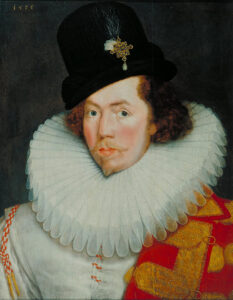 On this day in Tudor history, 23rd March 1596, in the reign of Queen Elizabeth I, soldier, member of Parliament and diplomat, Sir Henry Unton, or Umpton, died after being taken ill with “a violent, burning fever”.
On this day in Tudor history, 23rd March 1596, in the reign of Queen Elizabeth I, soldier, member of Parliament and diplomat, Sir Henry Unton, or Umpton, died after being taken ill with “a violent, burning fever”.
Unton had been taken ill after accompanying King Henry IV of France to the siege at La Fère. He was about thirty-eight years of age at his death.
Here are a few facts about this Tudor man…
- Unton was the son of Sir Edward Unton of Wadley, near Faringdon in Berkshire, and his wife, Anne Seymour, daughter of Edward Seymour, Duke of Somerset and Lord Protector, and the widow of John Dudley, 2nd Earl of Warwick.
- He was educated at Oriel College, Oxford and then the Middle Temple, in London. He also travelled through Europe in his youth.
- In 1586, he served as a soldier in the Netherlands and he and his friend, William Hatton, nephew of Sir Christopher Hatton, were knighted by Robert Dudley, Earl of Leicester, after distinguishing themselves at the Battle of Zutphen.
- In 1591, Unton was appointed as resident ambassador to France. He got on well with King Henry IV but was rebuked by Elizabeth I in 1591 for exceeding instructions she’d given him and then in 1592, when complained after having all his money and clothes stolen, everything but the nightshirt he had on at the time, the queen wasn’t exactly sympathetic: saying “she did bothe pittie, and yett thought strange howe it should be doane, you having soe many servants”.
- In 1593, he served as Member of Parliament for Berkshire and in 1595 he was reappointed as the resident ambassador in France due to the patronage of his good friend, Robert Devereux, 2nd Earl of Essex, the queen’s favourite at the time. His mission was to make sure that France stayed enemies with Spain.
- In 1596, he accompanied the French king to La Fère, where the French had the Spanish forces under siege, but fell ill with a fever soon after his arrival with what was described as the “purple fever”. The king was advised against visiting him, but risked it. Unton died on 23rd March 1596.
- His body was returned to England on a black ship, and he was buried in Faringdon, at All Saints' Church, in a lavish funeral on 8th July.
- As well as being a soldier, MP and diplomat, Unton was a literary patron, a diarist, a writer, writing a now-lost treatise on how to be a good ambassador, a linguist and a music lover.
- Unton was survived by his wife, Dorothy, daughter of Sir Thomas Wroughton, and she commissioned a posthumous portrait of her husband. It depicts Unton at his writing table, flanked by figures of Fame and Death, and he is surrounded by scenes from his life – him as an infant with his mother, studying, his European travels, his service in the Netherlands, his embassy, his life in England – him in his study, talking to divines, playing music, presiding over a masque and banquet, him on his deathbed, his body on board the black ship, his hearse, a funeral procession going past his house, his funeral, monument and his mourning kneeling widow.
It’s an incredible painting and here's a link to see it and all the different parts of it in detail, and to read about the research that has been done on the portrait - https://www.npg.org.uk/research/programmes/making-art-in-tudor-britain/case-studies/the-portrait-of-sir-henry-unton-c.-1558-1596
Also on this day in Tudor history...



Leave a Reply